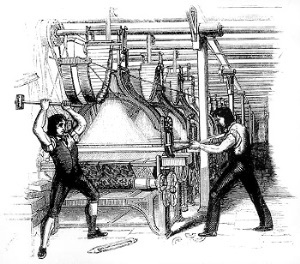How ‘Luddite’ and ‘Protected Market’ Resistance to Change Add Up
There are basically 2 types of resistance to social and technical change: the ‘luddite resistance’ and the ‘protected market’ resistance. And in the case of the Fourth Revolution, both add up when it comes to resisting change.
 Luddites in action in the 19th century
Luddites in action in the 19th centuryThe ‘Luddite resistance’ refers to the Luddite, those early 19th century frame breakers, qualified weaver artisans that broke the new weaving machines that only required unqualified labor. Those workers feared for the end of their trade, being replaced by machines.
The ‘protected market’ resistance refers to all those markets that for one reason or the other, have been protected (generally in the name of the common good to manage scarce resources or to enhance certain types of services) but the reason for this protection disappears with the Fourth Revolution. In general, many scarce services and goods are now becoming abundant.
As an example, taxi services generally form a protected market with regulated prices and numbers, in the name of public service. Drivers fear to be replaced by machines (the luddite resistance) and at the same time, the reason for market protection disappears as ride-booking apps replace taxi hailing.
This resistance to change analysis framework is actually quite useful to analyse all sorts of resistance to change even in organizations today. People fear that their job will be replaced by machines or information systems, and at the same time the reason for the protection and regulation of certain trades disappears.
In your case, what is the proportion of ‘luddite resistance’ and of ‘protected market resistance’?




